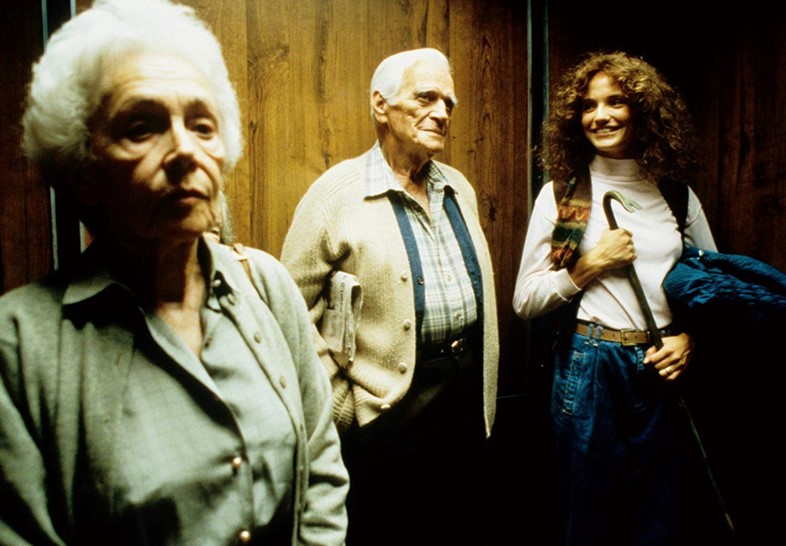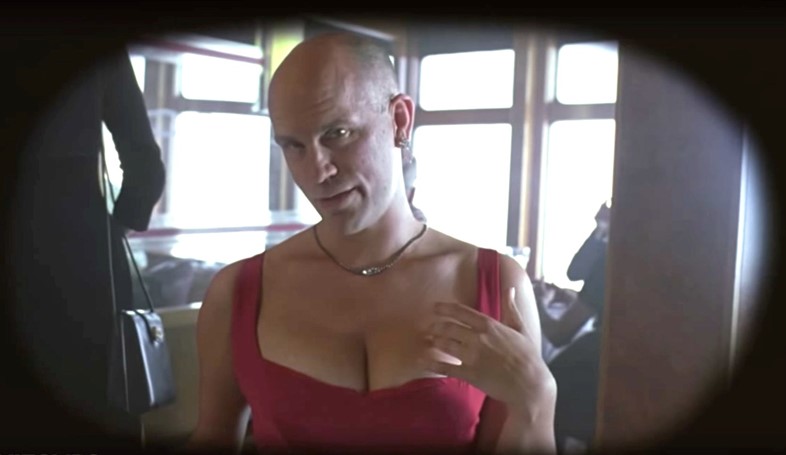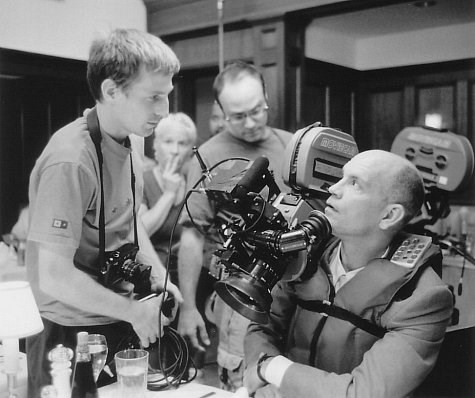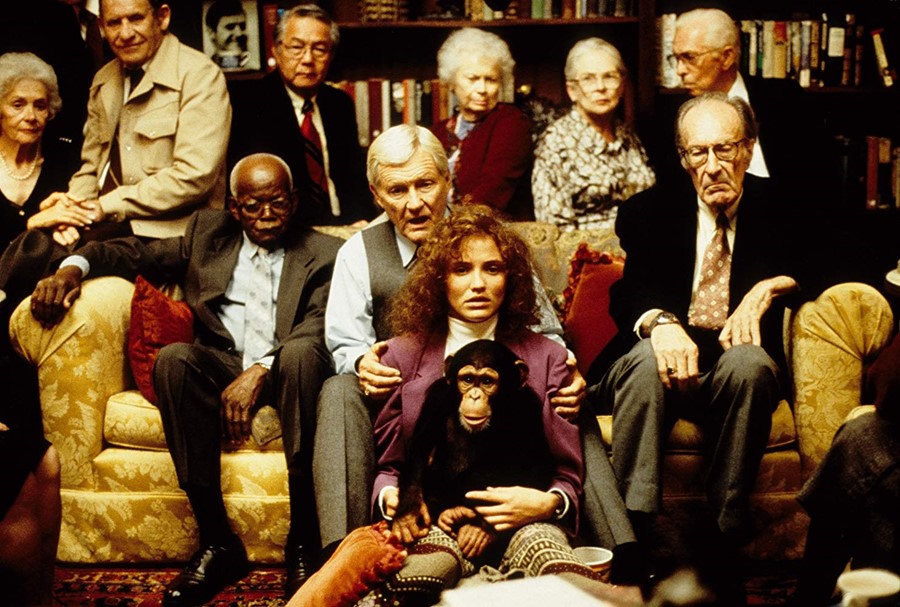A film that confronted our irrational obsession with celebrities, the urge to disappear from reality, and the fantasy of puppeteering a new exterior for ourselves
If John Malkovich did social media, his Instagram stories could resemble one of many scenes from Spike Jonze’s prescient 1999 comedy Being John Malkovich. In the Charlie Kaufman-written movie, a number of voyeurs venture onto floor 7½ of an office block and crawl into a portal to glimpse the world through Malkovich’s eyes: Malkovich eating breakfast, Malkovich cleaning the fridge, Malkovich catching a taxi. “Being inside did something to me,” Lotte (Cameron Diaz) enthuses after 15 minutes of watching Malkovich take a shower. “Everything made sense. I knew who I was!”
Of course, when Being John Malkovich premiered 20 years ago – September 2 at Venice Film Festival, October 22 in theatres – the internet was in its infancy and MySpace wasn’t even a URL. What caught on was the sci-fi concept’s underlying themes: the irrational obsession with celebrities, the urge to disappear from reality, and the fantasy of puppeteering a new exterior for ourselves. Jonze and Kaufman, intentionally or not, predicted the rise of social media by identifying the itch that humanity desperately needed to scratch. Even the film’s catchphrase – “Have you ever wanted to be someone else?” – doubles as a marketing tool for Twitter and Instagram.
Being John Malkovich, as a reminder, depicts a crumbling marriage between Craig (John Cusack), a greasy-haired loser, and Lotte, an animal lover whose array of household pets include a chimpanzee in a diaper. When his marionette performances fail, Craig temps at LesterCorps and falls in love with Maxine (Catherine Keener), a colleague who turns out to be a puppeteer in a less literal way. Then upon discovering a tunnel into Malkovich’s brain, Craig envisions two outcomes: Maxine might finally pay attention to him, greasy hair and all, and access to Malkovich’s fame could boost his own artistic exploits.
To contextualise the eternal sadness of Being John Malkovich, it’s worth remembering where Kaufman was in his career. In 1994, when the first draft was attempted, Kaufman was a frustrated TV writer without a movie credit. His early 90s were spent on comedy shows that would be swiftly cancelled, often before their first season finished airing. In his BAFTA Screenwriters’ Lecture, Kaufman recalled, “I was working on a sitcom and I could not talk… I was terrified in this room of six guys.” You envision Kaufman in a writers’ room, somewhere on the Fox lot, wishing he could sneak off to a covert cupboard and escape to a ditch on the other side of the city.

“It’s more relatable wishing you were important, rather than wishing you were still important”
But the nagging sense of self-loathing, a constant thread throughout Kaufman’s work, cuts deepest in Being John Malkovich. Of Kaufman’s seven produced screenplays, five have protagonists who are renowned writers. The other two, Being John Malkovich and Eternal Sunshine of the Spotless Mind, are his most beloved projects. That’s probably not a coincidence. Truth is, it’s more relatable wishing you were important, rather than wishing you were still important. Craig is a nobody who wishes he was somebody. If there was a portal into Craig’s head, who would crawl into it, let alone pay for the experience? Who would possibly want to be Craig? Craig doesn’t, that’s for sure.
Not that Kaufman believed Being John Malkovich would ever exist. “When I wrote it, I wasn’t working as a screenwriter,” Kaufman told Filmmaker Magazine, “and I wasn’t thinking that [Malkovich] or anyone else would actually read it.” In fact, the early draft I’ve read – it’s dated 1995 – is zanier and unfilmable, as if written for the page, and for the page only.
In an entirely different third act, Craig combats the Devil in a puppet-on-puppet battle involving Malkovich, a 60ft-tall Harry S. Truman doll, and a death-defying stage performance of Equus. When Craig loses, the Devil inhabits Malkovich’s body and enslaves mankind, forcing Maxine and others to dance for their Malkovich-shaped ruler as he hovers 10ft in the air. Around the corner, Lotte, rescued by escaped animals, makes out with her pet chimpanzee. The final scene reveals Craig to be a puppet himself. Over the closing credits, “Put Your Hand Inside the Puppet Head” by They Might Be Giants is supposed to play.
When Jonze read the script in 1996, he’d earned enough cachet from music videos to get the project greenlit. Still, even Jonze, a co-creator of Jackass, required Kaufman to tone down the wackiness. So the Being John Malkovich we have now is a darker, rawer, more human story, and the closest thing in it to the Devil is Craig.
However, Jonze set himself the same challenge, too. The director’s prior videos were loud, colourful and show-off-y: “It’s Oh So Quiet”, “Sabotage”, “Elektrobank”, “Drop”, “Buddy Holly”, “California”, and so on. But Jonze offers restraint, shooting Being John Malkovich with a dark and gloomy palette, as if a crew member forgot to change a lightbulb. Plus, considering its absurd premise, the movie is relatively grounded: even though everyone remembers the sequence with multiple Malkoviches, the majority of the scenes are sad people in rooms arguing about who’s sadder.
"We wanted a dingy naturalism in it to play against the science-fiction,” Jonze explains in a DVD extra. The director goes on to recall how financiers turned up mid-shoot and were aghast: they couldn’t recognise Diaz in her Lotte attire, and the lack of lighting meant “it didn’t look like a comedy”. So much so, the financiers insisted that cinematographer Lance Accord should be fired. Jonze refused, obviously.
By the time of production, Diaz was known as the blonde bombshell from The Mask and had shot her scenes for the soon-to-be-released There’s Something About Mary. Lotte, though, with her mangy brown hair, wouldn’t be caught dead in the cartoonish red dress of The Mask. Or, for that matter, Mary’s red dress from the Farrelly brothers’ romcom. Usually uneasy in her skin, Lotte develops a newfound appreciation for life after 15 minutes inside Malkovich’s body. It’s not the 15 minutes of fame, it’s the 15 minutes of something else. “It’s just that for the first time, everything just felt right,” Lotte exclaims. Later, she informs Craig, “Don’t stand in the way of my actualisation as a man.” It’s not really for me to say how sensitively these issues are explored, but it’s another sign Being John Malkovich was ahead of its time with subject matter.
But none of it would work without Malkovich’s involvement. From Kaufman’s first draft, it was always Malkovich. Malkovich, Malkovich, Malkovich. The name is funny to say, the actor’s confused pomposity is funny to watch. The film’s producers, including REM’s Michael Stipe, suggested Tom Cruise. But Being Tom Cruise sounds more like a Scientology exposé. Malkovich strikes the right level of fame: everyone’s heard of the name, but not a single character knows his credits.
The masterstroke is that no one, apart from Craig, actually feels what Malkovich feels. He’s just a vessel. The pleasure lies in someone – say, a taxi driver congratulating him for that “jewel thief movie” – looking at you differently, or even just looking at you at all. Being a mildly recognisable actor is a fantasy come true. And when that 15 minutes of fame loses its novelty, you’re back to being you. Even Twitter addicts have to log out now and then.

It doesn’t matter if Malkovich plays the next Bond or wins 10 consecutive Oscars – Being John Malkovich will always be his defining role. Well, duh. His name’s in the title. When Malkovich enters the portal, he lands in a restaurant where everyone bears his face and speaks his language: “Malkovich. Malkovich. Malkovich.” Maybe that’s how he feels now. In a 2015 interview, Malkovich referred to the film’s legacy as “kind of like if you get a blowjob from the wrong person, then your life becomes a blowjob.” Which suggests that Malkovich’s brain should be explored in real life, or that Being John Malkovich is a career achievement he will never top.
But Kaufman and Jonze still haven’t surpassed Being John Malkovich either. The fantastical landscapes of Eternal Sunshine are echoes of Lotte chasing Maxine through Malkovich’s memories, while Anomalisa and Synecdoche New York continue the meta-narrative of Craig’s puppet productions. Adaptation, Kaufman and Jonze’s 2002 collaboration, is literally about the Sisyphean task of following Being John Malkovich. And whereas Jonze’s Her feels less relevant as each year passes, Being John Malkovich improves upon each rewatch. How many viewings did it take for you to spot the cameos from David Fincher, Winona Ryder and Brad Pitt?

Although the director and writer refuse to elaborate on the film’s meaning, Malkovich is happy to propose his theories. “I think it's about the need to escape yourself for 15 minutes that everyone feels,” Malkovich told the New York Times in 1999. “But what it’s really about is something more sinister. It’s the idea that we now lead virtual lives. We live our joys and sorrows and foibles through the lives of public people. It’s about the end of art. Because art has to take its cue from life.”
The “virtual lives” comment turned out to be true in a different way. I’m sure when Being John Malkovich came out in cinemas, audiences identified with Craig, Lotte and Maxine. But modern viewers, even those without IMDb pages, can see themselves in Malkovich. Here’s an ordinary guy – he’s certainly no Tom Cruise – whose privacy is constantly hijacked, whose mundane actions are documented 24/7, and whose idle thoughts can be communicated around the planet within seconds.
And this is why Being John Malkovich still packs such a punch: if you have a social media profile, you’re inviting total strangers to crawl into your headspace and experience the world through your POV. And if you feel like entering your own portal, it’s called Facebook Memories. Like it or not, the tables have turned, and there are strings dangling above our heads: in 2019, we have all become John Malkovich.




